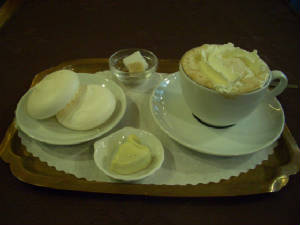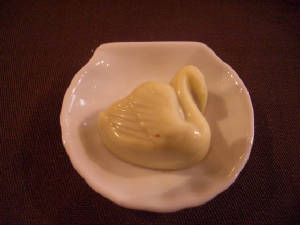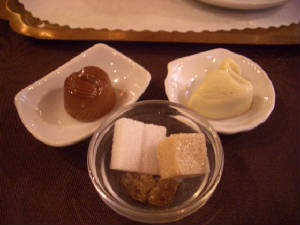| Formal setting with fish course |
|
|
| Example B |
| Formal Luncheon |
|
|
| Example C. |
| Informal Setting |
|
|
| Example D |
| Individual coffee service |

|
| Example F |

|
| Example G |

|
| Example H |
What is a formal setting? The components that
are required in a formal dinner setting have become impractical in modern times. Because they require a
spacious facility and experienced, professional staff, they
only still exist at formal state occasions. Think of it as a ceremonial performance with an elaborate setting, complex
script, cast and wardrobe. That doesn't mean that you can't come close with a little less formality. One big difference
is that the food is brought in from the kitchen on individual plates and served to each guest a course at a time. Thus,
no serving dishes are placed on the table. If a dish is passed, it goes from guest to guest and either returned to the kitchen
or placed on a side table. We will describe the
elements that you must include to call it formal.
- You
must have a table covering. Ideally, your table cloth should have a 12 inch drop all the way around. This means
that there should be 12 inches from the edge of the table to the hem of the table cloth. The unfortunate complication
of this is that your guests can get tangled in the cloth as it will hang in their laps. If you napkins match the cloth,
it is easy to pick up the cloth thinking it is the napkin. Though it may be a little less attractive, Lady Virginia
recommends a 8 to 10 inch drop as that will just brush the top of the lap when the guest is seated.
- You must have a centerpiece. This can be flowers, fruit or some ceramic
piece. Resist the temptation to make too grand a centerpiece as it can be a distraction. Keep it low so your
guests can easily see over it and feel comfortable talking with those across the table from them. Also, when selecting
a centerpiece think about how appetizing it may or may not be. Don't bring in a bunch of things from outdoors that may
have a strong smell or contain bugs or drop pieces on the cloth or in the food. Lady Virginia likes to have ceramic
pieces. There are less surprises, she says. For added interest, place them on mirrors.
- You will place a service plate
at each place. We'll stop a moment to explain these items as they are often misunderstood and misused.
- The service plate should be slightly larger than your dinner plate.
- The place in front of the guest should never be empty and a dirty plate is not replaced with the
next course. There must be an empty plate at the guests place in between courses. Therefore, the service plate
allows you to remove a dirty plate and put the plate with the next course on it. At the end of a course the dirty plate is
removed, leaving the service plate in place.
- For
example, the first course is placed on the service plate. It is removed and the soup bowl is placed on the service plate.
Then when the soup is removed the service plate goes along with it and the entree is placed in front of the guest directly
on the cloth. The entree is removed and the table crumbed before the desert is brought in.
- Dishes are served from the left and removed from the right.
- Candlesticks or candelabra
- Dishes with sweets and nuts
- Salt and pepper at each place (or for every two guests)
- Place cards
- No bread and butter plates!
Our example A shows a place set for a formal dinner with water, wine soup and shell fish on the
menu. It is traditional to serve the salad after the entree, however, modern tastes prefer that the salad be served
before the entree. Thus, you see the salad fork to the left of the meat fork in this case. This menu includes a shrimp
cocktail. The cocktail fork is placed on the far right. It is the only fork that is placed on the right
side of the plate. The desert utensils are at the top of the plate. Our example B is set for a fish course with the fish knife
and fork and also has a soup course. We have added a menu card at each place. It gives your guests a preview of what
will come. The coffee service is brought in and can be served at the table or the guests can withdraw to another room
for coffee. It is acceptable for the ladies to go to the living room for coffee and the gentleman can remain at the
table for conversation.
Formal luncheon:
A formal luncheon should be set on a bare table. There can be place mats or runners. There are no candles on a
luncheon table and bread and butter plates are included on the table of a formal luncheon setting. The cloth napkin
is smaller than the one used at a formal dinner. Depending on the weather you will probably find a clear soup served
in cups.
Our Example C (mistakenly
shown on a cloth...gotta fix that) is set for a simple menu without soup. Notice that the napkin is slightly smaller
than the dinner examples. Water and iced tea are being served and the spoon is on the table.
Informal table setting: Most of us want to be able to honor our guests with a
"formal" feeling but are limited both by space and experienced help. When the hostess goes to the trouble of preparing
an elegant setting with silver, crystal and china the guests feel very special. It gives everyone an opportunity to
dress up and feel pampered. You've seen us express this before, entertaining is a wonderful gift a lady can offer. Opening
up our home for guests is a very personal thing. Most people appreciate being included for such an event and will cherish
the memory for some time to come. Our example D shows how you can set a "formal" type table with modifications.
Though you will not have sacrificed this being a special occasion. You will see that there is a bread and butter plate and
a salad plate. A cream soup is on the menu and sparkling water will be the beverage during the meal. The salad
and soup can be on the service plate when the guests are seated. It might be more practical to serve a cold soup in
this case as it will be difficult to keep the soup hot while the guests are being seated. The hostess can have a serving
table near her place. This serving table should have more than one level so that you can keep the used dishes separated from
the fresh dishes. The hostess can place the used plates on the lower shelf of the serving table and serve the next course.
The entree and vegetables can be passed around the table and each guest can serve himself or herself. Then the serving
dishes are placed on the serving table. They are then available if someone wants a second helping. (This does
not happen at a "formal" dinner). You may want to alter which side you start passing the food on. Otherwise,
the same person will get the last choice each time. Remember, however, if you start them at the same time going around each
side, they will cross at some point which is awkward for the guest that must balance two items at once.
Family dining: Our Example E is very much like D but the hostess has chosen
a more casual china. She is serving a salad with the meal and no soup course. This will allow her to have everything
either on the table or at hand on the serving tray. She is serving iced tea and will have lemon and sweeteners on the
table for the guests to help themselves. Though we call this a "family" setting, it can easily be used for
your more informal entertaining. You see that though this is informal, it still suggests a "dressed up" event as
you are using your sterling, china and crystal.
Example F, G and H show you how you can make the coffee service something special. In another chapter,
we will be giving you menu suggestions to match these different styles. For now, this will get you started and provides an
alternative to paper plates!
We've added
this example of a dessert table set up in an adjoining room. Your guests can help themselves while the dining table
is being cleared and coffee prepared. Allow plenty of room for them to walk around. They will have been seated
for sometime during the meal and this allows them to stretch their legs while making their dessert choices. When you
know how to do it correctly, you can relax, enjoy your guests and have fun too!